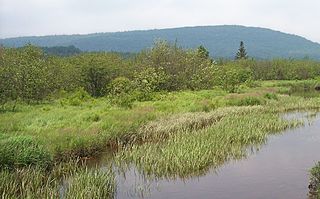
Toxicodendron is a genus of flowering plants in the sumac family, Anacardiaceae. It contains trees, shrubs and woody vines, including poison ivy, poison oak, and the lacquer tree. All members of the genus produce the skin-irritating oil urushiol, which can cause a severe allergic reaction. The generic name is derived from the Greek words τοξικός (toxikos), meaning "poison," and δένδρον (dendron), meaning "tree". The best known members of the genus in North America are poison ivy (T. radicans), practically ubiquitous throughout most of eastern North America, and western poison oak, similarly ubiquitous throughout much of the western part of the continent.
Mock orange or mock-orange typically refers to Philadelphus, a mostly Holarctic genus of shrubs, particularly the species Philadelphus coronarius, which is widely cultivated as an ornamental plant.
Cypress is a common name for various coniferous trees or shrubs from the Cupressus genus of the Cupressaceae family, typically found in warm-temperate and subtropical regions of Asia, Europe, and North America.
An elder is someone with a degree of seniority or authority.
Snowbell is a common name for several plants and characters and may refer to:
Rain tree is a common name for several plants and may refer to:

Cephalanthus occidentalis is a species of flowering plant in the family Rubiaceae that is native to eastern and southern North America. Common names include buttonbush, common buttonbush, button-willow, buck brush, and honey-bells.

Cephalanthus is a genus of flowering plants in the family Rubiaceae. There are about six species that are commonly known as buttonbush.
Buckbrush is the common name for several species of North American shrubs that deer feed on, including but probably not limited to:
Buttonwood or Buttonwoods may refer to:
Crucifixion thorn may refer to one of the following North American desert plants:
Palustris is a Latin word meaning "swampy" or "marshy", and may refer to:

Shrub swamps — also called scrub swamps or buttonbush swamps — are a type of freshwater wetland ecosystem occurring in areas too wet to become swamps, but too dry or too shallow to become marshes. They are often considered transitional ("mid-successional") between wet meadows or fens and conifer or hardwood swamps.
Odoratus is a Latin adjective meaning "fragrant, perfumed", and may refer to:
Cephalanthus salicifolius is a species of flowering plant in the family Rubiaceae. Common names include Mexican buttonbush, mimbre, botoncillo, and Jazmin blanco. Its native range extends from the banks of the southernmost stretch of the Rio Grande in Cameron and Hidalgo Counties of Texas through much of Mexico from Coahuila to Oaxaca; a disjunct population exists in Honduras.
Algarrobilla, small carob in Spanish, also written algarovilla, may refer to :
C. occidentalis may refer to:
This page is based on this
Wikipedia article Text is available under the
CC BY-SA 4.0 license; additional terms may apply.
Images, videos and audio are available under their respective licenses.



